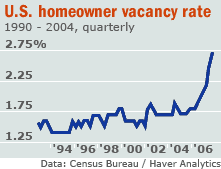By Bonddad
bonddad@prodigy.net
From CBS.Marketwatch.
The number of vacant homes waiting to be sold surged 34% to 2.1 million at the end of 2006 compared with the end of 2005, by far the fastest increase ever recorded, the Census Bureau reported Monday.
A year ago, 1.57 million homes were vacant and awaiting a sale.
The vacancy rate for owned units jumped to a record 2.7% from 2.0% a year earlier. From 1965 to 2005, the homeowner vacancy rate had never been above 2%. The long-term average is 1.4%.
First, note the long-term average is 1.4%. So the current market is way above the long-term average. Also note the average has never been above 2 million units. Again, we're way above the long-term average on that as well.
Here's the chart that accompanied the article. Notice the rather large spike in the vacancy rate:
That spike is really large and indicates there is a fundamental problem in the market from the supply side of the equation.
First of all, let's see what we are measuring. Here is the Census Bureau's definition of vacant home:
A housing unit is vacant if no one is living in it at the time of the interview, unless its occupants are only temporarily absent. In addition, a vacant unit may be one which is entirely occupied by persons who have a usual residence elsewhere. New units not yet occupied are classified as vacant housing units if construction has reached a point where all exterior windows and doors are installed and final usable floors are in place.
Basically, these are free-standing houses no one is currently living in. In addition, notice the second part of the definition: "vacant unit may be one which is entirely occupied by persons who have a usual residence elsewhere. That part of the definition would encompass flippers, or people who purchased homes with the intention of quickly reselling them.
Overall, here's the basic problem:
"We have more than a million housing units of excess supply," said James O'Sullivan, an economist for UBS. "If you are looking for evidence that the worst is over for housing, you're not going to find it in this report. This argues that housing starts need to go down more."
In 2006, the number of housing units in the United States rose by 2.14 million, or 1.7%, to 126.7 million. The number of units occupied, however, rose by less than half as much -- 1.04 million.
Meanwhile, the homeownership rate (the percentage of homes occupied by their owners) was essentially steady at 68.9%, the government said, close to the all-time high of 69.3%.
Last year the number of units increased by a little over two million, while the number of occupied units increased half as much. Econ 101: excess supply = decreasing price. Or, we still probably have a way to go before housing hits bottom.

No comments:
Post a Comment